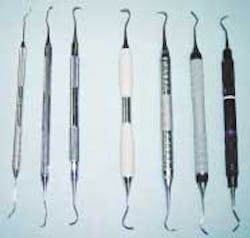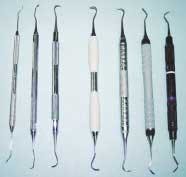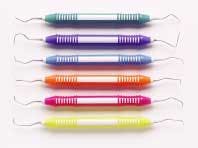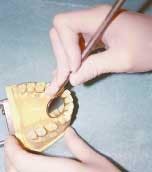Within your grasp
Understanding the fine details of instrument design and selection
By Anne Nugent Guignon, RDH, MPH
Ergonomics is a big buzzword today. Many industries are concerned about workers developing workplace-related musculoskeletal disorders. Over the past two decades, more and more dentists, hygienists, and assistants have developed both short-term as well as permanent disabilities. Often these disabilities are a direct result of repetitive stress injuries directly related to tasks that we perform in the dental office.
Two of the biggest factors contributing to injuries are the types of hand instruments we use, as well as how we use these devices. For example, everyone involved in clinical practice uses a hand-held mouth mirror. This instrument can provide a significant source of irritation to the muscles, nerves, joints, tendons, and ligaments in a clinician's hands, forearms, shoulders, and even the upper back and neck. Since most mirror handles never die, there are many skinny metal handles in use every day. Some of these older handles also very heavy.
To help reduce the ergonomic stresses hand instruments put on the body, instrument manufacturers are developing new handle designs that greatly reduce these stresses. Larger diameter instruments limit pinch/grip, which results in a more relaxed hand posture. This is one time when thin is not in!
Years ago, instrument handles were either octagonal with tiny cross hatching texture, or they were round and smooth. Companies are now focused on creating different types of texture patterns on the handles. Texture equals traction, especially in wet conditions, which are prevalent in most dental procedures.
Along with larger diameter handles and textured surfaces, most instrument handles are no longer solid metal. Ergonomists know that excess weight can create unnecessary stress and fatigue. The choices now range from hollow metal, resin/metal combinations, and silicone/metal designs to all resin models. Both hollow metal and metal/resin designs reduce the overall instrument weight. Some instrument handles are padded. These designs feature padded silicone grips fitted over a metal core. All-resin instruments, which are the lightest, became available about a decade ago.
What can you do if your instrument is skinny but still serviceable? Add a medical-grade silicone grip to increase the handle diameter. Several entrepreneurial hygienists who can no longer practice because of workplace-related injuries, have invented products that fit the bill perfectly. Both the Chub EZE (above) and ErgoGrasp grips (right) can enlarge any slim handle. Both products are autoclavable, improve handle texture, create a comfortable, cushiony grip, and come in a variety of colors.
The Acushy grip (left) is a disposable cigar-shaped grip that fits beautifully over a mirror handle, giving the clinician a relaxed, cushioned grip, which is critically important when using a mirror as a retraction tool. Many clinicians suffer from hand and thumb pain because they use a "death grip" on the handle during retraction. Some use surgical retraction tools rather than mouth mirrors. These devices have a larger gripping surface, which can reduce overall hand fatigue.
In addition, there are instruments such as scalers and curettes that do not last forever. These instruments require regular sharpening. Sharp instruments allow clinicians to perform exacting procedures with much less force, resulting in reduced hand and forearm fatigue. Clinicians using sharp instruments are more efficient and patients are more comfortable when instruments are sharp.
Each time an instrument is sharpened, the blade becomes smaller. Hand sharpening is not only tedious and time-consuming, but many clinicians have difficulty maintaining a precise edge on a scaler or curette. This is particularly common if more than one clinician sharpens the same instrument. Countless instruments are damaged because of poor sharpening techniques.
Dental manufacturers now offer some very precise sharpening systems, which can virtually eliminate operator errors as well as greatly extend the useful life of a scaler or curette. Much less metal is removed when instruments are sharpened with an automatic sharpener on a regular basis. While automated sharpening devices cannot be expected to resurrect an instrument that is worn out or has been damaged by poor sharpening techniques, it is ideal for maintaining a sharp edge on new instruments. In the end, instruments that stay sharp and last longer will offset the cost of an automated sharpening device.
Several companies offer instruments that have replaceable tips. This allows clinicians to develop their own customized instruments. Another advantage to this system is the ability to replace a broken tip and put the instrument back into service immediately.
Some dental practices attempt to operate with a bare minimum number of instruments or set-ups for routine procedures. How much time, effort and valuable production time is wasted when the office staff scurries around looking for a set of instruments? Typically, offices that have this practice philosophy go into a tizzy when an extra patient is squeezed into the schedule or instruments are not out of the autoclave in time or, heaven forbid, an instrument drops on the floor. Having an ample number of instruments allows clinicians to practice more efficiently, and reduces unnecessary stress in the workplace.
It is important that clinicians be allowed to select the instruments that work best in their hands. Wise employers respect a clinician's personal preference for the type and number of instruments needed for each procedure. For example, the length of the instrument handle can vary between manufacturers. Clinicians that prefer an instrument with a longer handle will not feel comfortable using one that is short. In addition, not all clinicians have the same hand size. This can have a significant impact on instrument selection. Serious golfers, cooks, or gardeners require tools and instruments that work well in their hands and allow them to have predictable, outstanding outcomes. Dental professionals need to view instruments in the same way.
Anne Nugent Guignon, RDH, MPH, practices clinical dental hygiene in Houston, Texas. She writes, speaks, and presents continuing-education courses on ergonomics and advanced ultrasonic instrumentation through her company, ErgoSonics (www.ergosonics.com). She can be reached by phone at (713) 974-4540 or by e-mail at [email protected].
Mirror, mirror...
The mirror is an instrument that each of us uses daily. Here are a few suggestions to make this all-purpose tool more helpful than ever.
- Double-sided mirrors improve the volume of light as well as clinical efficiency. Smaller diameter mirror heads are invaluable when working with small children, patients with limited openings, or those who have a sensitive gag reflex.
- Take an inventory of your mirrors. If the surfaces are scratched or dull, replace them with new ones. Poor quality, worn out mirrors make it difficult to provide high quality dental care. Keep a package of autoclaved mirror heads right in the treatment room and replace worn out heads in a timely fashion.
- There are commercially available products that will help keep the mirror fog-free, but mouthwash will work as well. It changes the surface tension so water flows off in a sheeting action rather than forming droplets on the face of the mirror. Either dip the mirror into a dappen dish full of the rinse, or periodically wipe a piece of mouthwash-dampened gauze over the surface of the mirror. Pre-moistened gauze squares can either be stored in a container or prepared at the beginning of each appointment. Mouthwash in a small spray bottle can also be applied directly to the mirror surface.







